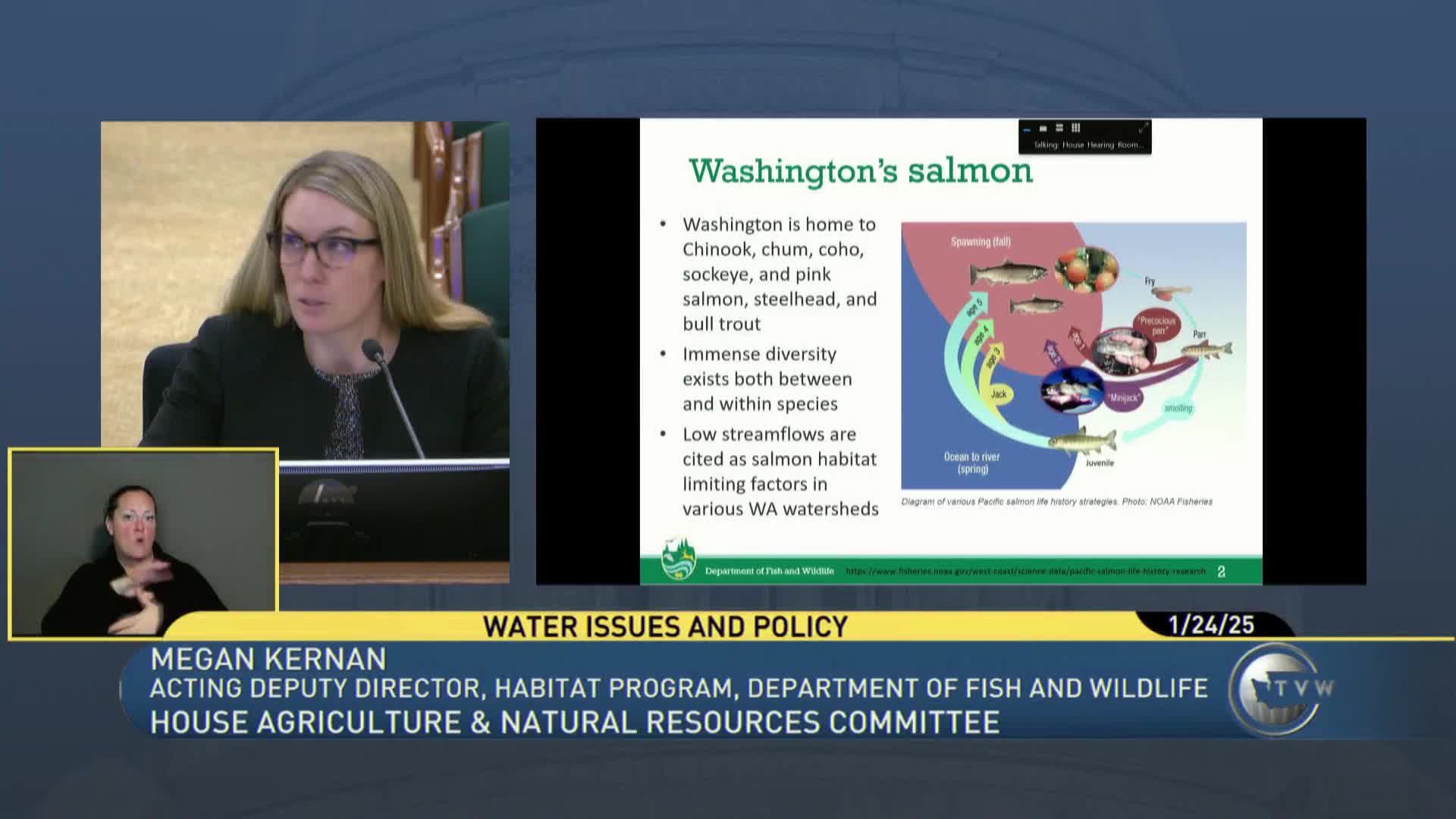Washington State faces salmon crisis as low stream flows threaten diverse populations
January 24, 2025 | Agriculture and Natural Resources, House of Representatives, Legislative Sessions, Washington
This article was created by AI summarizing key points discussed. AI makes mistakes, so for full details and context, please refer to the video of the full meeting. Please report any errors so we can fix them. Report an error »

Washington State's salmon populations face critical challenges, as highlighted in a recent meeting of the House Agriculture & Natural Resources Committee. The discussion centered on the health of five species of Pacific salmon—Chinook, Chum, Coho, Sockeye, and Pink—as well as steelhead trout, all of which have thrived in the region's waters for over six million years. However, the meeting underscored alarming trends in salmon populations, with ten out of fourteen federally protected groups currently in crisis.
Key factors affecting salmon health include low stream flows, which are impacting various life stages of these fish. The committee emphasized that inadequate water levels are not only a summer issue but also affect streams during winter and spring, creating bottlenecks that hinder salmon migration and spawning. The meeting presented data from the Governor's Salmon Recovery Office, revealing that while some salmon populations are making progress, many are struggling to survive.
The committee also discussed the vital role of stream flows in maintaining habitat connectivity, which allows salmon to access spawning grounds and marine environments. Healthy stream flows support sediment transport, temperature regulation, and dissolved oxygen levels—critical elements for fish survival. The connection between groundwater depletion and surface water availability was highlighted as a growing concern, particularly in Eastern Washington, where declining aquifer levels threaten salmon habitats.
To address these challenges, the committee explored various strategies, including process-based restoration efforts, water conservation initiatives, and the potential for reclaiming wastewater. These approaches aim to enhance stream flows and restore ecosystems, ensuring that salmon populations can thrive in their natural habitats.
As Washington State grapples with the impacts of climate change and water scarcity, the discussions from this meeting signal a call to action for effective management strategies to protect and restore the state's vital salmon populations. The committee's focus on research and adaptive management will be crucial in shaping future conservation efforts and ensuring the sustainability of these iconic species.
Key factors affecting salmon health include low stream flows, which are impacting various life stages of these fish. The committee emphasized that inadequate water levels are not only a summer issue but also affect streams during winter and spring, creating bottlenecks that hinder salmon migration and spawning. The meeting presented data from the Governor's Salmon Recovery Office, revealing that while some salmon populations are making progress, many are struggling to survive.
The committee also discussed the vital role of stream flows in maintaining habitat connectivity, which allows salmon to access spawning grounds and marine environments. Healthy stream flows support sediment transport, temperature regulation, and dissolved oxygen levels—critical elements for fish survival. The connection between groundwater depletion and surface water availability was highlighted as a growing concern, particularly in Eastern Washington, where declining aquifer levels threaten salmon habitats.
To address these challenges, the committee explored various strategies, including process-based restoration efforts, water conservation initiatives, and the potential for reclaiming wastewater. These approaches aim to enhance stream flows and restore ecosystems, ensuring that salmon populations can thrive in their natural habitats.
As Washington State grapples with the impacts of climate change and water scarcity, the discussions from this meeting signal a call to action for effective management strategies to protect and restore the state's vital salmon populations. The committee's focus on research and adaptive management will be crucial in shaping future conservation efforts and ensuring the sustainability of these iconic species.
View full meeting
This article is based on a recent meeting—watch the full video and explore the complete transcript for deeper insights into the discussion.
View full meeting
